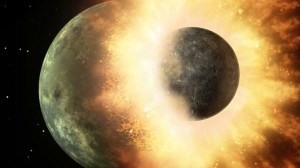How the Moon Was Made (Note, No Cheese Involved)
Monday, April 13th, 2015April 13, 2015
One problem with the theory of the moon’s origin may have been solved. Alessandra Mastrobuono-Battisti and Hagai B. Perets from the Israel Institute of Technology in Haifa and Sean N. Raymond from the Laboratoire d’Astrophysique de Bordeaux in France published their findings on the formation of the moon last week in the journal Nature.

An artist’s impression of a collision between Earth and a planet-sized object. The Moon was likely formed by such a collision. Scientists now think the object was very similar to Earth in composition. (Credit: NASA/JPL-Caltech)
Most scientists think that the moon formed as a result of a collision known as the Giant Impact. According to this hypothesis (a possible explanation for what is observed), Earth collided with a planet-sized object about 4.6 billion years ago. As a result of the impact, a cloud of vaporized rock shot off Earth’s surface and went into orbit around Earth. The cloud cooled and condensed into a ring of small, solid bodies, which then gathered together, forming the moon.
The Giant Impact hypothesis predicts that the moon would be formed mostly of the remains of the impactor (the object that struck Earth), but the makeup of the moon is actually very similar to that of Earth. Studies had suggested that the likelihood of an impactor being so similar to the planet it hits to be about 1 in 100. The unlikelihood of such an event led some scientists to look for other hypotheses to explain the formation of the moon. Whenever new data was found, however, it usually still supported the Giant Impact hypothesis.
Mastrobuono-Battisti, Perets, and Raymond created a computer model of the early solar system to study the formation of planets and impactors. In their analysis, they found that impactors had a composition similar the planets they crashed into about 20% to 40% of the time, not 1% of the time as had been previously thought. Thus, the Great Impact hypothesis is not as improbable or unlikely as scientists once thought, and scientists can now accept it is the most likely explanation for how our moon was made.
Other World Book articles:



